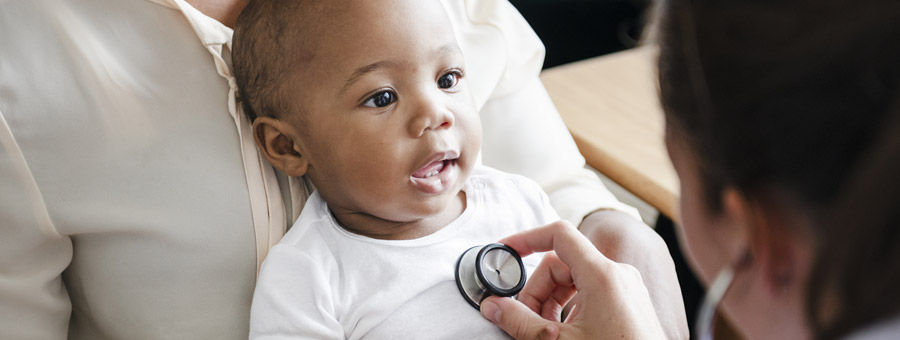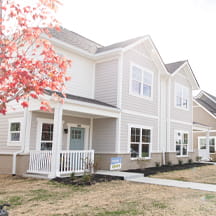Bridgette Jones knows asthma.
Jones, M.D., MSCR, a pediatric allergist and immunologist at Children’s Mercy Kansas City, spends her days helping patients manage the condition. One patient with severe, uncontrolled asthma visited her clinic regularly, showing significant weight increases each visit. Jones reviewed his diet to identify the cause of his weight gain.
The common denominator at every meal: fried food. “I told him that’s the issue—all the fried food,” Jones says. “He looked at me and said, ‘Dr. Jones, our stove is broken. The only thing we have is a fryer.’ They couldn’t afford to get their stove fixed. Here I was thinking I had addressed the situation. I had no clue what this family was dealing with.”
Jones’ response is common. Patients present with a myriad of social, economic and environmental factors that influence their health, referred to as the social determinants of health (SDOH). The concept of SDOH gained traction in the early 2000s as the World Health Organization began drawing attention to how social factors reinforced health inequities, especially within the most vulnerable populations.
Today, the COVID-19 pandemic and social justice movements have highlighted inequities and racism that have existed for generations, and children’s hospitals are renewing their focus on delivering more equitable care. Inequities are not driven by a single issue—there is a web of barriers and inconsistencies facing racial and ethnic minorities and lower-income families driving poorer health outcomes.
Children’s hospitals’ efforts alone will not result in child health equity. But they have an important role in reducing variation in care based on SDOH and ensuring processes across their health systems are conducive to optimal health for every patient and family.
Increasing accountability
For John Cowden, M.D., M.P.H., health equity integration project leader at Children’s Mercy Kansas City, the events of the last year revealed how variations in health outcomes connect to SDOH.
“Environmental and community factors used to seem like they were outside the work of the hospital,” Cowden says. “But if our organization’s financial health is tied directly to how healthy—not how sick—a patient is through value-based care, we have a moral, mission-based and now financial interest in the well-being of the child. Therefore, we’re interested in things like housing, the environment and job opportunities for parents.”
Kevin Fang, M.D., FAAP, general pediatrician at Children’s Hospital Los Angeles (CHLA), says the work to be done to achieve equitable care can feel overwhelming given how much community need there is. “The flip side is that everything is connected,” he says.
“You alone don’t have to tackle everything. Every little ripple that you can make, if everyone else is also making a ripple, eventually that becomes a wave, and a wave becomes a tsunami. That creates change.”
The list of potential disparities that drive inequitable outcomes is long, but they fall into categories—access to care, socioeconomic status, communication barriers, unconscious bias and racism—all of which are linked to SDOH and can inhibit equitable care for families.
Access to care
A lack of access to care is indicative of several systemic challenges along a patient’s journey. A patient could live in an area without health care providers within a reasonable distance. A family could also live in an area that doesn’t have providers who accept their health insurance, which will inhibit access to care, regardless of the volume of providers. Or a family could lack transportation to get to appointments.
And in scenarios where a family does see a provider, is it the right one? Limited access, whatever the cause, can lead to families showing up in the emergency department (ED) for lower-acuity needs. In most circumstances, a child is going to receive higher quality and more cost-effective care for a lower-acuity visit through a primary care physician.
“Children need access to effective care, which is received at the time they need it and affordable to families,” Cowden says. “Families who have a lower income are less likely to receive effective care.”
Elizabeth Miller, M.D., Ph.D., FSAHM, medical director, Community and Population Health at UPMC Children’s Hospital of Pittsburgh, sees the next level of access to effective care as “receipt of care.” This means considering what did the hospital do to ensure families knew their options and felt comfortable with them?
For example, most children’s hospitals leverage mobile vans in communities with lower socioeconomic status or limited access. Despite positive intentions and the availability of essential services, maybe only a few families show up. The perception may be there is little community need, but Miller encourages asking a few questions before reaching that conclusion.
“What did we do to ensure the most vulnerable, most marginalized families knew we were going to be there?” she asks. “What did we do to make sure families wanted to receive care? That is what health equity looks like. It’s not solely that we sent a van out and call that access to care. Our role is also in building our trustworthiness so that families want to receive care from us.”
Lower socioeconomic status
One in seven children in the U.S. lived in poverty in 2019, according to The Children’s Defense Fund. This amounts to nearly 11 million children, and 71% are children of color. “Poverty influences everything—where you live, what schools you attend, what level of pollution you’re exposed to, which affects cognitive development,” Fang says. “ZIP code determines more than genetic code in terms of life expectancy.”
For example, a Black person is twice as likely to be diagnosed with asthma than a white person, and it’s a condition in which management is greatly dependent on one’s environment, such as where they live. Wanting to understand more about asthma among Children’s Mercy’s patient population, Jones identified asthma hot spots in the Kansas City area.
Communities where children had the most hospitalizations and ED visits for asthma are predominantly in the city’s Black and Latino communities, which are historically areas of disinvestment leading to barriers to healthy living.
During the COVID-19 pandemic, Jones and medical student Aarya Ramprasad conducted a similar exercise. The first wave of the virus struck the hardest in mostly Black neighborhoods. When looking closely at what health care access was like in those areas, Jones and Ramprasad found half as many primary care providers—and double the number of COVID-19 cases.
“For illness, especially chronic diseases like asthma, this reinforces inequities that need to be formally addressed,” Jones says. “I can teach a patient to manage their health condition, but our goal should be to prevent that child from developing it in the first place. Let’s figure out why certain populations are overburdened with disease.”
Communication barriers in health care
Communication challenges can contribute to a negative experience with the health care system, lack of or unnecessary additional care, and as a result, poorer health outcomes. Cowden recognizes that providers often use technical terms and assume a level of understanding patient families may not have when communicating with them.
“Sometimes, we approach care and communication about the care in ways that create issues for a family’s understanding,” Cowden says. “To move towards greater health equity, that has to change. My goal is to make sure I become better educated in how my communication can be more effective in meeting the patient’s and family’s needs.”
One of the ways providers can adapt their communication style is through closed-loop communication. At the end of the visit, the patient, parent or caregiver is asked to repeat in their own words what they’ve understood about the diagnosis, treatment and post-visit instructions.
Cowden says he’s quickly able to tell if the family understands and what needs to be explained differently. “Families get home and realize they didn’t understand, or they wanted to be polite during the visit and not challenge a person they see as an authority,” Cowden says. “Closed-loop communication in every interaction is one step toward ensuring families are not disadvantaged by our words and communication styles.”
Non-English-speaking families can also have challenges getting care they need and tend to have higher re-admission rates. For families who speak multiple languages, medical encounters are ideally conducted in their native language but that can pose a challenge when considering the number of languages spoken in many areas.
When a family came to CHLA speaking Q’anjob’al as their native language and Spanish as their second language, the team searched for a Q’anjob’al interpreter—and found one. The Q’anjob’al language comes from one region of Guatemala, has only about 180,000 native speakers and is representative of the diversity of children’s hospitals’ patient populations.
Telelanguage, an interpreter service, finds the top 15 largest metro areas in the U.S. each have at least 126 languages represented, with some cities like New York having at least 192 languages spoken at home.
Racism and unconscious bias in health care
Children’s hospitals are at different points in their work toward greater child health equity, a byproduct of diverse patient populations, resource availability and historical investment.
But regardless of where they are now, hospital leaders say the current social environment lends itself to more intentionally addressing racism, which the Centers for Disease Control and Prevention declared in April is a serious threat to the public’s health. “Everyone has unconscious biases to uncover,” Fang says. “It is uncomfortable, but without discomfort you don’t grow.”
Cowden says there is unprecedented interest and energy among employees who want to better understand racism and bias in health care. “But letting people try to figure it out on their own is not going to get us as far as offering employees the chance to talk about race and racism at their hospital,” he says.
Bias and racism in health care have grave implications on patient care. A 2016 study found 73% of white medical students held at least one false belief about biological differences between races. These inaccuracies can influence care, including how pain medications are prescribed and how often people of color are admitted after presenting to the ED.
“Hospitals have to get into the foundation of each team’s work and root out racism,” Cowden says. “You can’t have safety unless everyone behaves safely. Equity is the same. It can’t be left to a small group. Looking at how each person works helps you develop processes that improve equity.”
Miller says she used to support unconscious bias training to help employees identify and address their own prejudices. But her opinion changed alongside the country’s recognition of structural racism.
“We’re shifting towards anti-racism training, which integrates aspects of what we can do individually to recognize biases but adds perspective on the ways our industry’s practices are unjust,” she says.
For example, many health care organizations have punitive late-show policies that create inequity for low-income families. And for families that rely on public transportation, showing up to appointments on time can be expensive and subject to obstacles beyond their control. In Pittsburgh, buses to the hospital’s downtown location can cost a family $7 one way and take nearly two hours.
“It may take three buses for them to get here,” Miller says. “Now they’re hours late and told they won’t be seen, instead of, ‘We are happy you made it. Let’s figure out what care we can provide today and get you the additional services you need.’ Anti-racism training is focused on helping people understand and dismantle those types of policies.”
First step toward greater equity
The diverse populations unique to the communities each children’s hospital serves make it difficult to prescribe common solutions to eliminating inequities across organizations nationally.
Children’s hospitals vary in sizes and structures and come to the table with different levels of resources, community partnerships and experience in addressing disparities. But as organizations identify a path forward, there are things providers can do and learn from each other.
As a first step, individual interactions can set the stage for better outcomes. Fang says providers are responsible for asking how they can help to better understand what options are realistic for the patient before jumping to solutions.
“Maybe your patient is overweight, and you prescribe exercise,” Fang says. “Before telling them to run or walk more, ask questions. Maybe there are no sidewalks in their neighborhood. Maybe it’s an unsafe area. If you learn that, you can recommend indoor or digital options.”
The same principle applies to asthma. Identify what social supports a family may need so they can make the home environment healthier in addition to or as part of an asthma action plan.
At Children’s Mercy, Cowden is practicing this philosophy and normalizing the concept that providers ask families how they can help—not just regarding the initial visit.
“We are asking, ‘How can we help beyond checking your child’s ears today?’” he says. “This has been powerful for us. Families will share something critical to their well-being only because we asked. We can show families we’re there for them in more ways than just conventional medical needs.”




